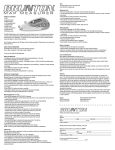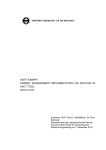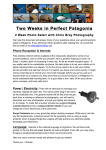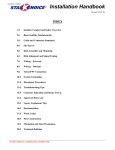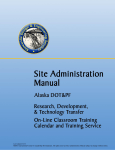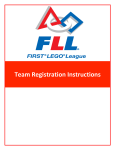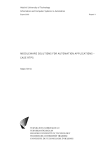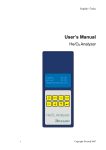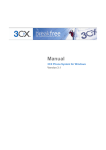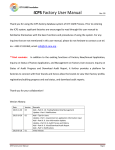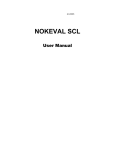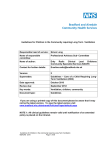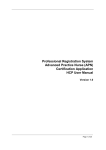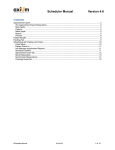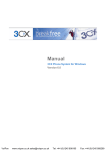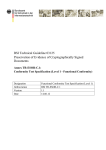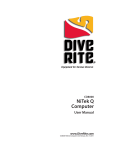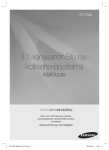Download Introduction manual for booking system ResPax
Transcript
Introduction manual for booking system ResPax – Case company Stray Ltd. Rinja Oksanen Bachelor‟s Thesis Degree Programme in Tourism May 2015 Abstract Date 1.6.2015 Author(s) Rinja Hilda Tuulia Oksanen Degree programme Bachelor’s degree in Tourism (TOBBA) Report/thesis title Introduction manual for ResPax booking system – Case company Stray Ltd. Number of pages and appendix pages 24 + 28 This Bachelor‟s thesis contains an introduction manual of ResPax Booking system for a travel company Stray Ltd. running hop on hop off coach network services in New Zealand. The manual was written based on the theory, research and by company‟s requirements. The first chapter introduces the company and the booking system. It also explains on how they work together in order to have successful business. The tools of getting the most benefit out of the system and methods are introduced with a SWOT analysis of the booking system. Process of development presents the most beneficial steps of the training and the goals. In the end of the theory there is the description of the manual written from both, the case company and the thesis writer. The introduction manual produced is following a well-structured order working as a base for well-planned training. The employee introduction guide to Respax is recommended and necessary to be handed to all new employees starting work as a part of Stray Ltd. reservations team. It could also be presented as an electronic version. Respax booking system introduction guide is being presented as an attachment at the end of the report. Keywords Introduction, manual, tourism, booking system, training Table of contents 1 Introduction ................................................................................................................... 2 2 Case company introduction ........................................................................................... 4 2.1 Introduction to ResPax .......................................................................................... 5 2.2 ResPax for case company Stray Ltd. .................................................................... 5 2.3 SWOT analysis of ResPax .................................................................................... 6 2.4 Methods used ....................................................................................................... 7 3 Recruiting process ........................................................................................................ 9 3.1 Interview ............................................................................................................... 9 3.2 Selection ............................................................................................................. 10 4 Introduction to booking tools........................................................................................ 11 4.1 Five steps of training ........................................................................................... 12 4.2 Teaching goals.................................................................................................... 13 4.3 Monitoring the training and learning process ....................................................... 14 4.4 Summary ............................................................................................................ 15 5 Development process of ResPax manual .................................................................... 17 5.1 Implementation ................................................................................................... 17 5.2 Testing the manual ............................................................................................. 17 6 Description of the user manual .................................................................................... 19 6.1 Evaluation of case company ............................................................................... 20 6.2 Own evaluation ................................................................................................... 20 7 Discussion................................................................................................................... 22 7.1 Learning process ................................................................................................ 22 7.2 Future ................................................................................................................. 24 References ...................................................................................................................... 25 Appendices ...................................................................................................................... 26 Attachment 1: Introduction manual for ResPax booking system .................................. 27 1 Introduction Tourism industry offers different options and ways on working on the field. One of them is work in fast paced tourism company in New Zealand which offers hop on hop off coach network services for adventurous backpackers. Tourism industry has high standards on professional customer service as people who are on a holiday tent to have extremely high expectations on their trips. Therefore the service the customers are receiving will need to be professional in all fields to keep customers satisfied. The case company using the booking system ResPax is called Stray Ltd. and it is offering professional tourism services in New Zealand. This thesis was prepared for the company as a support system for training of the booking software for new employees. The case company Stray Ltd. has teams of members behind the scenes making sure professional service is given to customers. One of the main teams is reservations team, who is responsible of bookings, updating coach manifests including all passengers‟ names and answering customer‟s and agents questions. This team uses the booking systems on daily basis and the main one, ResPax, is presented in this thesis. The project objective was to create an introduction guide for ResPax booking system for the teaching process for the new employees as well as a backup for all members of staff. The main goal was to have step by step guide with pictures of the system without having to use any fancy terms, difficult to understand. The guide included all parts of the booking procedure and all additional tasks that were being done with using ResPax while working for Stray Ltd. reservations team. The information and data was received by using qualitative research. The research was made by collecting the material from ResPax booking system, mostly through own learning and getting ideas from other companies‟ manuals. During the making collection for the manual was made by own work experiences and with a help of other staff in order to get the right amount of information and the tasks which needed to be on the manual. As the subject of the thesis is an introduction manual for ResPax, the training period and familiarizing different methods of training are important as well. As every person starting the learning process is different, individual training methods need to be considered. Teaching is the most crucial part of the job as work communities and work environments change constantly. That is the reason training is important in order to get the new employee prepared and ready for the work as soon as possible. 2 For the thesis project I was the leader working together with Stray Ltd. The collection of information of the topic happened while working for the company. First working period was from September 2013 till January 2014 as a work placement intern, a part of the studies in HAAGA-HELIA and then fulltime from September 2014 till March 2015. Both times I was working as a member of the reservations team, using ResPax booking system on daily basis. 3 2 Case company introduction Stray was founded by Neil Geddes in 2002 in New Zealand. He was one of New Zealand‟s true backpacking industry pioneers and also started another hop on hop off coach company, Kiwi Experience back in 1988 which is still running in New Zealand as well. (Stray Ltd 2015) Stray Ltd. runs a guided hop-on hop-off coach network mostly for backpackers. Passengers travel by coach around New Zealand along with 30 to 40 other travellers. The average passenger age is from 23 to 35 year olds. There are multiple different passes to purchase for both islands and the pass determines the route. With average of five departures a week from the main cities around the summer period gives passengers flexibility to hop off and on as many times as they want depending of the time they have tin New Zealand. (Stray Ltd. 2015) While touring around the country, the coach drivers work as guides telling passengers facts, history and famous stories about New Zealand. The drivers are also responsible of booking the accommodations and activities for the passengers along the way. Stray coaches run regularly all year around and all passes are valid for 12 months from the first day of travel. However the most popular way of travelling is to stay on the same coach all the way to the city or stop passengers are ending their tour or travels in New Zealand. In order to travel the biggest bus pass Stray has, which includes the whole New Zealand, in one go, would take approximately 38 days. Stray hires interns working as a member of the reservations team all year around. During the busy summer period, from October to March, the company has two to three fulltime employees and rest are interns which makes the total amount of team members of six or seven. The usual period of time for internship is 5-7 months. The management has decided 5 months is the minimum for internship in reservations team as the training will approximately take from 1, 5 months to 2 months. The company also has same kind of coach network system running in South East Asia, including Thailand, Laos, Vietnam, Cambodia and the latest addition was Myanmar. The system running tours in South East Asia is fairly new so with collaboration with another company Stray had decided to have another booking system for those tours. 4 There are a team of employees working around South East Asia making sure everything runs smoothly for everyone. The reservation side for Asia is one part of the reservations team work in New Zealand as well. However the main booking system team uses daily is ResPax as it includes all sectors the company needs for in New Zealand. 2.1 Introduction to ResPax ResPax products have been created 10 years ago in Australia in a company called Trinity Software Australia Pty Ltd. Their programs are designed to suit a broad range of operators from the smallest one hour day tours to the largest international organisation. (ResPax 2015) The ResPax reservations software automates the following tasks which Reservations staff can manually do: monthly reports, ticketing, bus manifests, combination itineraries, tax invoices, and snorkel deposit form. The system organises all the components and timings of bookings and extras such as buoyancy vests, for printing on the voucher and inclusion in reports for staff on board the vessels, the Accounts Department and management. (ResPax 2015) 2.2 ResPax for case company Stray Ltd. ResPax is managing the company‟s complex scheduling requirement enabling Stray to book passengers on partial legs of specific routes. ResPax is pulling all the bookings together and is helping Stray roster resources and print manifests for each of the coaches on daily basis. (ResPax, 2015) The main work done with ResPax in Stray reservations team is to book passengers into the system by adding all passenger details provided and possible travel dates. The reservations team will book passengers to ResPax after receiving an email to the reservations email about an online booking. The other option is by finishing a booking over the phone with an agent calling from New Zealand or Australia. Agents around the world are also emailing bookings through to reservations. Reservations team will then book passengers in and reply to agents email with confirmations. 5 When the coach pass has been paid, all passengers receive a confirmation email, possible travel itinerary if travel dates were give while processing the booking and log in details to an online booking system. Passenger can start editing the travel dates and stops as soon as they have started travelling. They have options on either calling to reservations team to change travel dates along the way or then change dates themselves online by using an online booking system connected to ResPax. One of the key tasks for reservations team was printing out manifests every evening in order to keep updates and passenger records accurate. As it is a legal acquirement, the drivers update the numbers of passengers on the coach at every stop along the way. The reservations team then updates the changes to the booking system in order to have the correct numbers at all times. For example if an accident happens on one of the coaches, the head office would know which of the passengers were on the bus at the time of the accident from the printed and updated manifest. Therefore the ResPax manual is significant to have, if a member of staff is uncertain of how a particular job is done. 2.3 SWOT analysis of ResPax This paragraph contains a SWOT analysis of the booking system. It will be analysing and explaining the strengths, weaknesses, opportunities and threads ResPax as a booking system has and might have in the future. The analysis will bring out all four different aspects about the subject that SWOT table then introduces. In universities of applied sciences the thesis is often team work between company, student and school. The basic guidelines concerning subject, schedule, data protection and counselling are set between parties. One tool for evaluating is the SWOT –analysis. When assessing the strengths, weaknesses, opportunities and threats, the actions to these should not be forgotten. (Anttila 2007, 142, 154) The strength of ResPax is the easiness of the system after the basic learning process has finished. Even though it still has small details and tasks that needs to be remembered in order to finish a booking, where the manual comes in handy. ResPax also has a 24hour support system in case of any system mail functions. The last strength is the diversity of the system. It can be modified from hourly daytrip bookings to bigger hop on hop off coach network bookings. 6 The first weakness of the system is that it only works online. In case of a power cut or if internet goes down, as it does happen in New Zealand, it causes difficulties. The system also has a lot of updates that might cause breaks at work when ResPax is not working at all for a certain period of time. As it was mentioned earlier the last weakness is that the system is old, which is the main reason for updates. The booking system has opportunities such as expanding to other countries in Australasia. At the moment they mainly operate in Australia and New Zealand. New look for the system could bring the system to the same level where the latest booking systems are instead of updating the old version. New and faster software systems are being created every year. The usability of the system and the latest, complex models of new systems could be a threat for ResPax as the system was created 10 years ago. Table 1: SWOT analysis of ResPax Strengths Weaknesses Easy to use Works only online 24h support system Constant updates Diversity Old system Opportunities Threats Expand to other countries New, faster booking systems New look for the system More complex systems 2.4 Methods used There are multiple different tasks and fields that a new member of staff in reservations team must learn. The same basic training will take its place for interns and part/fulltime employees as everyone is part of the same team. The main teaching method at Stray reservations team uses is called rooming-in care. This method has been noticed to be the best one for the reservations team as there are multiple different fields and tasks to be learned. 7 New members of staff start the learning process by following another team member on how the work is done. The rooming-in care method means that all new members are being taught individually. Supervisor or another member of staff right for the job will be teaching the newcomer step by step while working on their own tasks. 8 3 Recruiting process Companies use social networking sites or they are advertising jobs on their own website. When the company is in a need of hiring people, they need to make sure they are hiring right employees for the job. The case company is using both of these actions advertising available jobs. Recruitment process organizations are seeking to attract and retain the interest of suitable candidates, whilst at the same time also seeking to portray a positive image to potential applicants. Of course recruitment is a dynamic process as within organizations people are constantly retiring, resigning, being promoted or, at times being dismissed. Equally, changes in technology, procedures or markets may all mean that jobs are re-configured and become available to the external labour and thereby trigger the recruitment and selection process. (Nickson 2007, 90) In order to start the recruitment process with potential applicant there needs to be a job description for the job so the right people can apply. A document that outlines the purposes of the job, the task involved, the duties and responsibilities, the performance of objectives and the reporting relationships. It will give details of the terms and conditions, including the remuneration package and hours of work. In many respects the job description can be thought of a functional document which outlines the ´what` elements of a job. It should aim to prove clear information to candidates about the organization and the job itself, such that it acts as a realistic preview of the job. (Nickson 2007, 91) 3.1 Interview Interview is the most popular way of recruiting new employees. That is the next step once the company has received and gone through the job applications and found the right applicant s for the job. From overall evaluation processes, interviewing is the most common technique. For the past two decades there have been researches about different interview methods which have grown the knowledge, its weaknesses and strengths. Even though the method is good it is not the only way of evaluating people and their skills. Some jobs require special skills and certain kind of personality in order to succeed which can be difficult to evaluate during an interview. (Niitamo, 2001, 16) 9 The goal of interview and the whole recruiting process is to get as professional evaluation of the applicant in as the interviewer can in order to hire the right people. By the information received from the applicant during the interview, the interviewer creates an image of the person working for the company and being part of the team. (Niitamo, 2001, 23) The informal method of interviewing is the traditional way which has been used on creating evaluation applicants. Informal interview process does not follow a certain pattern or structure. Interview begins and follows on spontaneous questions including topics that have been though through in advance. (Niitamo, 2001, 28) By reflecting the theory of the recruiting process to the case company, the informal method used for interviews would be the most productive way for the company to handle interviews. It would be testing the language skills as the company has about 40% of overall staff from abroad and also the interviewer would see if the person has the personality for the job. 3.2 Selection The next step at the recruiting process is selection of who is the most appropriate person for the job. This part of recruitment takes place after all applicants have been interviewed. The first idea is that the selection process is a two-way process. Often the perception is that the organization has all of the power in the process of selection. However, this is not strictly true, even though it may seem that way when you are going through the process. Selection is in fact a two-way process, because people have the option to pull out of the process or turn down for a job. (Nickson 2007, 105) The second point is the selection criteria. Selection does not have a place in vacuum, there is also the context of whether the person will fit in with the job requirements, so the person/job interaction is important. There is also the question of whether the person will fit in with the organizational culture and the way things are done in particular organization. (Nickson 2007, 105) 10 4 Introduction to booking tools In order to get the training period to start in a productive way, all steps of the training need to be well prepared. Employee introduction guide for Respax typically contain information about the booking system, which might raise questions among the workforce. Mentioned guides save time for employees, supervisors and managers since employees can confirm the information independently from the introduction guide without asking for help. A new employee can follow the step by step guide while learning on processing new bookings into the system. Teaching new employees well in early stage is crucial for both employer and employee especially in a busy tourism industry. Learning the system carefully is essential as most of the bookings are made through the phone with a travel agent. The training and development provided within tourism, hospitality and leisure companies is also very variable quality and focus. There are plenty of examples from large as well as small businesses where the training is conducted on a limited and specifically ´needs must´ basis in order to meet the short- term skills requirements of the company or unit. However tourism, hospitality and leisure businesses increasingly recognize the importance of education, training and development as components within the wider strategic development of the company and its markets. (Baum 2006, 223) The main benefits while training new employees is to decrease mistakes. Faults can cause negative image for the company and loose customers. The knowledge of mistakes being made travels faster to possible customers than a job well done. The credibility of the company decreases if mistakes are constant and the customer service is unprofessional. Good training and support system will help the company and its employees to raise the reputation inside and outside. A company with good reputation is keeping employees satisfied, the turnout of staff decreases and the quality of work continues being high. (Kjelin & Kuusisto 2003, 20) By means of the new employee quickly decides during the first days whether they like the work community or not. A positive first impression is crucial, and the better the introduction is, the more likely the newcomers are to stay in the company. If they are left to cope alone, their motivation is reduced. (Hämäläinen & Kangas 2007, 5) 11 4.1 Five steps of training One of the most popular methods of training for a job is called the five step method. It can be adapted to fit the training for each company. Before starting it is important to be prepared. Preliminaries have done carefully will save time. The time and place will need to be taken care of and booked for the training period. (Hämäläinen & Kangas 2008, 14-15) The first step is starting the training session. The starting level, the topic that will be taught and the goals of learning will be evaluated. It would be beneficial for the adviser to create supporting and trustworthy interaction with the new employee which will created positive motivation and attitude. (Hämäläinen & Kangas 2008, 14-15) The second step is teaching. A full picture of the learning goals will be created during the progress. The process is good to split into sections to make it easier to understand and learn. The advisor will go through all tasks step by step while making sure nothing is missed or misunderstood before continuing to teach the next topic. It is important to explain why certain tasks are done as they are, as it will support the learning process. By actively getting the latest member of staff to feel as they are a part the group, they ask more questions which makes it easier to evaluate the progress and if anything needs to be double checked it will be done immediately. (Hämäläinen & Kangas 2008, 14-15) Creating an image of the work is the third step of the training. By doing that the employee focuses on the performance and succeeding at it. It also helps on improving the inner models which are the ones that guide human‟s actions. When a person is experienced and seen as a professional at their work, they do not have to think what they are doing as the inner models are giving directions automatically. The advisor can ask the new staff member to talk through each task taught to them, in order to understand why things are done in a certain order and the importance of each step. (Hämäläinen & Kangas 2008, 16) The forth step is to practice and test the new skill. This step is making employee to start putting the learned skills into practise. The advisor is there for support but will be letting employee to work independently. Afterwards the situation will be evaluated. This way employee will learn to evaluate their own work and think about the work they are doing. Afterwards the feedback is given by the advisor. This step is being repeated until needed. (Hämäläinen & Kangas 2008, 16) 12 Observing is the fifth and last step of the training period. If the meaning of the teaching process was to get the new employee to work independently, it will be tested. The advisor will be close enough to give support but at the same time will be continuing to do their individual work. A good way of testing the knowledge of the employee is to get them to tell other members of staff how a certain task is done. (Hämäläinen & Kangas 2008, 16) Before the season starts in New Zealand the reservations team is prepared to train new employees on the job. The five steps are being used on the training process as it has been proved to be one of the most successful ones when the goal is to get new employees work independently. As all seasons are different and sometimes it might get busier earlier than predicted. Even so the training methods used do not change. The significance of training period will show when the company is receiving feedback from all sectors. Good reviews and feedback are crucial as social media, online reviews and discussion forums have grown to be the public sites where people visit and read other peoples comments and reviews before deciding where to go for a holiday and which company, hotel or transportation to use. 4.2 Teaching goals The main goal in training and introducing a new employee to the company is get them to be part of the working team as soon as possible. There are three main objectives for this: individual learning, managing work and being part of the work environment. The most important goals in training are to decrease uncertainty, mistakes and misunderstandings. (Kjelin & Kuusisto 2003, 46-47) Typically there are topics that create questions every year, no matter how long the employees have been working for the company. As an example an older member of the company who has not used the system in a long time might have to start using it again where the manual comes in handy. The manual for the booking system is to increase the knowledge of the employees, and the ability to cope and work independently. Timing of the training is recommended to be considered well in advance. During the busy season the resources for training can be inadequate. On the other hand hectic season can be a great way of learning by jumping into the work and learning by doing. However there is always a risk that there is not enough time for appropriate training. (Kjelin & Kuusisto 2003, 242) 13 One of the common reasons for poor training is rush. Training is minimal or then it is done badly. While other employees are working on their own tasks, it can be difficult to find time to teach the latest member of staff. Therefore it is crucial for everyone in the team to know the benefits of good training. (Kjelin & Kuusisto 2003, 241-242) If an employee does not have enough information concerning the company and the work they are doing, the quality and efficiency of the work will suffer. People frequently claim that they do not have the information or enough of it and keep that as an excuse. While often there is more information available than people can assimilate. (Juholin 2009, 85) While writing an introduction manual, the information should be organized into a rational order. The spelling and punctuation should be checked properly – mistakes show that there has not been enough time consumed for the product. Repetition should be avoided to not to lengthen the document too much. Long and difficult sentences and words make the audience lose their interest. Before sharing the document, it should properly be proofread. (Baker 2012, 44-45, 71, 80) 4.3 Monitoring the training and learning process Observing the training is a key part of a successful training process and also important for possible improvements. Evaluation of the new employee and the training functionality are significant for any improvements. Education and training in today‟s change society no longer fits into traditional life models. The nature of social and working life today, particularly in developed countries, is one of constant change and with this instability comes a requirement to acquire new skills and to anticipate and adapt to changing circumstances. Changes in the workplace driven by new markets, new legislation, new opportunities and new labour-market pressures mean that on-going learning in the workplace is now expected of many employees at all levels. (Baum 2006, 235) During the training process the employee will learn about the company, the work community and the work they will be doing as a part of the team. Primarily they will learn by doing. This way all members of the team can be taught individually. (Kupias & Peltola 2009, 35-36.) 14 Immediately as the latest member of staff has been trained well, they will start making profit for the company. The sooner this happens the better it is for both parties. The meaning of good introduction and training is best known in companies that tent to hire young employees which makes the teaching significant. (Kjelin & Kuusisto 2003, 9, 14) When evaluation is done in a team, the progress objective has a base that can be modified later on. While going through the learning goals with employee it is important to start a conversation where the new member of staff will get to say their opinions, goals and learning plans. While the training process is being evaluated, both employees work and the person responsible of the training are being considered. (Kjelin & Kuusisto 2003, 245) For the case company Stray, the training period for busy summer season starts in early stage. September and October are the best months training for the employees working for the summer before the hectic months starts. One of the reasons for interns working for the summer season ideally would be starting in August and September in order to train them properly. There are enough everyday jobs to be done and bookings to be made in order to have a good training process. During the months of August, September the office is not too busy which means all tasks can be explained and the booking system can be taught so the employee has time to learn them throughout before the busy season starts. 4.4 Summary The training period is the most important part when starting a new job. Usually there is a technical system that needs to be learned. The manual written is planned the way so it is working on the side supporting the actual training period. All members of reservations team need to be communicating with each other all day. For example telling the team if something has happened or if a passenger is lost and cannot find the stop coaches are picking them up. The members of the reservations team need to know everything what is going on as they are all working together. These were only two examples that can happen which explains how important the training period is. 15 The work crew, other members of the team and more importantly the advisor along with the new employee are all responsible of the outcome for the training, how the new person is taken care of and how they feel about the work. Training needs to be planned in advance if the company is hiring new employees for example for upcoming busy season. The time scheduled for the full training potentially would be two months. In that period of time the employee has time to evaluate themselves, work and all of the tasks learned. At any point during that period, testing of the already learned skills is necessary. Testing will help new employees to memorize all learned tasks and grow confidence on the work they will be doing. When planning, timing of the training and learning goes fine, all members of staff are confident and ready for the season. The team members need to remember that if there are any raising questions the new member of the team will not be left alone. All raising matters will be explained so everything is understood. As the company is giving great opportunities for students through the intern program it is crucial for the company to make sure the work placement period is successful. The main goal for the internship is that by the end of the period the student is doing the same tasks with all the other team members and by that they could be hired to be a full time employee. This gives all reservations interns a full picture of the work, the company and a glimpse of the professional tourism work field. 16 5 Development process of ResPax manual The topic of the thesis came up during the work placement period in December 2013 after discussing about different subjects that would be beneficial for the case company. As they did not have a working manual during the internship I did with them, I learned the system by listening and writing my own notes during the training. The company wanted to have a working manual for the booking system as a support for the learning period and to have one printed version at the office for everyone‟s use if anything needs to be checked. The project itself started in the end of September 2014 after I had started working for the company. The idea of the thesis was discussed throughout with the reservations manager and by receiving ideas and the access to the booking system; the planning started taking its place. 5.1 Implementation The tools I was given were the usage of the booking system itself where I got all the pictures for the manual. As I could not work on the thesis while working I started the process from getting the pictures of all steps of the booking process. Collecting all the information I needed for the manual took a long time because I did not have access to the booking system from home. Text was added later when working on the thesis from home. The text supporting and explaining the pictures I wrote from the notes I had written throughout my own learning period during the internship. By using the notes I had written for myself, it helped me to understand which of the topics, which needed to be explained more carefully, were. 5.2 Testing the manual The first testing of the ResPax manual took place between the months of October 2014 to January 2015 while I was in New Zealand. The manual was handed for the employee where they would test if it was giving all information needed for the learning process. Between the four months the actual writing of the manual took its place as I received the ideas for improvements during that time period. Improvements and corrections were taken into notice and corrected before continuing on writing new. 17 The process of making the manual took longer than expected. During the busiest summer months writing the manual was lesser but after the first version of the manual was ready I started writing the theory part. During the spring semester of 2015 the theory and the introduction manual was written and completed. 18 6 Description of the user manual The introduction manual for ResPax has 28 pages. The manual has a cover page, table of context and an acknowledgement page the case company uses for greeting the latest employee and for most recent news the company has. The first page is starting with a list of commonly used words with explanations while working with the booking system. The manual itself introduces the procedure of logging into the system, a normal booking, searching for already existing bookings and instructions on how to book multiple customers at the same time. It also includes on how to book a driver sale or an upgrade done on the road. The manual shows the steps of updating and booking coach passes to custom passes if a passenger has purchased two passes under one booking, as well on how to book a travel leg for a passenger or for a re-traveller. And the procedure of putting manifests online and updating them. The outlook of the manual was planned on so it has pictures of example bookings and text to support the pictures with explanations. The step by step method was used as following the pictures it will help on finding the right buttons to press and information that needs to be filled in. The names of the places used in example bookings are actual stops Stray has along the way. The manual is planned to be handed for the latest member of the team during the first days when the training of the booking system begins. It will be used as a support of the actual training where another member of staff will be teaching on how the booking system works. The main training is done face to face. During the first week an advisor will be going through each product the company has to offer and guiding through each booking step by step. More tasks are given and new jobs are being taught depending on how fast the learning process is taking. When the booking system is learned, there will be new tasks for example using the system while booking with an agent over the phone. Here the manual is important as a support system if employee need to check something while talking on the phone. The manual is one part of a bigger introduction manual of the company which is including main information about the company, the house rules and information about emergency situations. 19 As mentioned before once starting to work for the reservations team there are a lot of tasks to learn but also knowing the map of New Zealand is crucial. Employee will get the latest brochures which include the maps and all stops Stray goes for daytrips and overnights. It has not been included to the manual as all new employees will have the brochures next to them while learning the booking system. 6.1 Evaluation of case company The evaluation of the process and the outcome from the case company has been positive. Since January the manual has been ready for training use. Here are the main points that were pointed out by the case company they were wanting from the manual and that were succeeded. The main points given for the manual were for it to be clear for anyone at the office to understand. By meaning, avoiding multiple page manuals with a lot of text. The language of the manual was easy to read with no difficult vocabulary. If any special vocabulary was used it can be found from a list of keywords used in the manual and also will be explained by the advisor while training. Adding pictures to the manual of the actual bookings is making the training process easier for both parties. Table of context made it faster to find distinct sections from the manual. For the future usage and editing of the manual, the company pointed out that it could be challenging if Microsoft Word would not be the software they are using. 6.2 Own evaluation The making of the manual and the whole project was challenging. As I have not made a manual for any booking systems before, at first I did not know where to begin. When I was starting to learn the booking system in the beginning of my internship I found it very complicated at first. There was no training program for the system which meant all bookings made were for real passengers. Even though the booking system was already familiar I learned a lot about it during the process on which I believe the manual will be helpful for the company. I also hope the company will continue of using the five steps of training for ResPax along with the manual. 20 My own opinion of the system is that new employees can find it old and hard to learn if they do not have any experience of any other booking systems. For example there are a lot of small points to remember, on which employees can find insignificant at first, in order to continue with the booking. 21 7 Discussion On behalf of the company I was given free hands on creating the thesis. While writing the manual I was given feedback whenever the supervisors had time and when I had questions or needed the guidance. Most of the planning and ideas were discussed in the beginning. Most of the information was collected from ResPax happened while working at the office before the busy season started by the approval of the management. Working for the reservations team, while writing the manual, was extremely helpful as I learned useful facts about the booking system during the process. I found the project successful even though project took longer than I originally planned. The writing process helped me to see the full picture of the making and through feedback that was given to me gave me and idea what was the right amount of information needed in order to produce a working manual. If there were a manual with long chapters and words difficult to read, it would not be pleasant to read. ResPax as a booking software system is relatively easy to use if the person starting the learning process has experience already. As Stray has interns all year around and some of them possibly have not used any booking systems before the manual will make training easier. The table of context is also helping on finding the instructions needed. The aim was to create competent and functional introduction manual of the booking system for new employees. The list of tasks that was given to include to the manual was fulfilled by using my own experiences and by the list given and discussed with me. The point of the manual was not to create something that the employee will read before starting the training but to have as a support in order to be able to work independently after familiarizing the booking system first. 7.1 Learning process While working on the thesis I familiarized myself on variety of literature and internet material referring to introduction manuals, guides and handbooks. Though different sources, I used for the thesis, I learned different ways of teaching the latest member of the company and how important training is, both for the company and for the employee. By reading the literature I wanted to bring out the best options of training for Stray. 22 I believe this has increased my professional knowledge through reading about the subject and by thinking on how different methods can be used in different companies training periods. The literature used for the thesis gave me vital information about training new employees and what it takes to make an introduction manual from the beginning which I will be beneficial for me in the future. The software systems can be challenging to learn so I have confidence in that the earlier experiences I have from other booking systems was helpful. For example another introduction manual for a different booking system can be written by using the structure of this manual. What I found challenging when I started writing the manual was that ResPax booking system was already familiar to me from the internship I did couple months before starting the writing process of the thesis. I started the process by thinking how I felt about the system while learning the system in the beginning of my internship. I also used my notes I had written while being taught of the tasks that needed to be remembered in order to be a member of the reservations team and the notes for learning the booking system. Another thing I found challenging was that most of the time I was writing the thesis I was in New Zealand. I believe it would have been easier and more helpful for me to be in Finland during the process. This project taught how to efficiently search for information from different sources. I learned special tourism terminology and found new aspects of my own learning process while working on the thesis. The method I found myself working was writing after work and memorizing the jobs done during the workday and then checking later on that week at work that all details written were in fact correct. This technique helped me to understand the system better. During the process I benefited by getting an understanding on how introduction manual are being prepared and how to create something from the beginning while thinking the next person reading the manual has not used or seen the booking system before. Thinking about the future I could see myself needing this skill. The project gave a good overview of everything related to the system which is the most important part. As a tourism student it is important to learn to use as many booking systems as it will be beneficial to have the experience. It also is helping on learning new booking systems as they all have similarities. 23 The making of the manual came handy for me as well as I can now count that as one of my new skills. I also believe it will be helping me to learn new possible technical systems used in tourism industry. In the future if I get asked to write similar introduction guide for another company, I feel confident enough to write another one because of the knowledge I have received while writing this thesis. Reading about different methods of preparation and writing the theory part of the importance of training and the methods used gave me new information about the process. It also opened my eyes to understand why other companies tend to have better working environment and happier employees. It is all about supporting all workers along the learning process and later on as well if needed. 7.2 Future The introduction manual for ResPax will most likely be modified in the future as the system will be having more updates. Monitoring of the manual and the experiences of the learning period by using the manual as a support is meant to be followed though emails. If and when the manual needs any updates the company will have the same files which they can easily update there and then. The manual will also be printed out so it will be in the office for everyone‟s use. There will be a folder where it is easily found. If there are singular pages that need to be modified or edited later on, it can be done by rewriting the parts that need to be corrected. The busy summer period in New Zealand tourism industry will be starting again in the end of September and that would be the time when the manual will come in use. There will also be two or three new interns starting their work placement periods in the next few months. This period will be the best time and chance for placing the manual into testing. This manual could be used as a framework for other manuals and for other companies as well. As an example for the other booking system called Junction 6 Stray is using for the South East Asia bookings. Thinking about the future the manual written could be published as an electronic version. While creating further plans for the manual, there could be a system training video made of ResPax which could be one part of the learning process added to the full training. 24 References Anttila, P. 2007. Realistinen evaluaatio ja tuloksellinen kehittämistyö. Akatiimi Oy. Tampere. Baker, H. 2012. Successful business writing. How to write excellent and persuasive communications. Universe of Learning Ltd. Lancashire. Baum, T. 2006. Human resource management for tourism, hospitality and leisure; An international perspective. Thomson. London. Hämäläinen, J & Kangas, P. 2008. Perehdyttämisen suunnittelu ja toteutus. 2nd ed. Työturvallisuuskeskus. Helsinki. Juholin, E.2009. Viestinnän vallankumous. Löydä uusi työyhteisöviestintä. 2nd ed. WSOYpro. Helsinki. Kjelin, E & Kuusisto, P. 2003. Tulokkaasta tuloksentekijäksi. Talentum. Helsinki. Kupias, E & Peltola, R. 2009. Perehdyttämisen pelikentällä. Palmenia Helsinki. Nickson, D. 2007. Human resource management for the hospitality and tourism industries. Elsevier. Burlington. USA. Niitamo, P.2001. Työhaastattelu. Henkilöarviointi työhönotossa ja työuralla. Edita Oyj. Helsinki Oxford Dictionaries 2015. Oxford dictionaries. Language matters. URL: http://www.oxforddictionaries.com/. Accessed: 16 April 2015. ResPax 2015. Trinity software Australia Pty Ltd URL: http://www.respax.com.au/index.php/products/respax-enterprise/respax-enterprisefeatures. Accessed: 14 January 2015 Stray Ltd. 2015. The Stray story URL: http://www.straytravel.com/why-stray/the-straystory/. Accessed: 10 January 2015 25 Appendices The manual for the case company Stray Ltd. can be found here as an attachment: The Introduction guide for ResPax booking system for Stray Ltd. The manual will start with an acknowledgement for the year with latest news and a welcome message for the newest member of the reservations team. The manual continues with step by step guide through booking passengers into the system and then to the other daily tasks that are included for the reservations team members work. 26 Attachment 1: Introduction manual for ResPax booking system Introduction manual for ResPax – Stray Ltd. 2015 27 Table of contents 1 Acknowledgement January 2015 .................................................................................. 2 2 Respax .......................................................................................................................... 3 2.1 Stray Reservations System - Respax Manual ....................................................... 3 2.1.1 Section 1 – Logging on to the remote desktop ........................................... 3 2.1.2 Section 2 – Making a new booking. ............................................................ 4 2.1.3 Section 3 - Search for an existing booking. .............................................. 10 2.1.4 Section 4 - Copy to multiple for multi pax bookings .................................. 13 2.1.5 Section 5 - How to process a Driver Upgrade........................................... 15 2.1.6 Section 6 - Creating a Custom Pass......................................................... 18 2.1.7 Section 7 – Creating a Custom Pass in a current booking. ....................... 20 2.1.8 Section 8 – Booking a leg of travel. .......................................................... 22 2.1.9 Section 9 – Booking a travel leg for a re-traveller ..................................... 24 2.2 Manifests ............................................................................................................ 26 2.3 How to update Manifests..................................................................................... 27 1 Acknowledgement January 2015 Welcome to the latest edition of the Stray Ltd. ResPax Manual. Big changes are happening this year as Stray has added a new booking system Junction 6 next to ResPax booking system which can be used for Stray Asia bookings. In an effort to keep things simple, this particular manual deals with the basic day-to-day running of the Stray reservations team and the New Zealand products (NZ Hop-on, Hop-off and Stray Journeys). A separate manual concentrating on Stray Asia and Junction 6 will also be available in the future. This document is here to assist the whole team in making Stray work like a well-oiled machine. As time passes and the seasons and staff change, this manual will adapt accordingly. We as a well working company aim to make this as up-to-date and accurate as humanly possible and always welcome updates and additions as they arise. We have drawn from the wide range of resources and information available to create this manual, in hopes of having a well-rounded central resource for all of our staff and crew to use. Thanks to all, Stray Limited 2 1 1.1 Respax Stray Reservations System - Respax Manual Welcome to the Orange Team! I am the Reservations Manual, designed to help you with the basic instructions on how to make new bookings, book multiple passengers, upgrades and how to book legs of travel for existing passengers. Here are key concepts that are being used in the manual. Travel leg is meaning a certain route starting from city A and ending to city B including stops along the way. Term is commonly used while working with ResPax booking system and planning passengers hop on hop off routes. Manifest refers to a daily list of passengers travelling on the coaches. Pax means the passenger travelling with the company. 1.1.1 Section 1 – Logging on to the remote desktop 1. To log into Respax, please use the Remote Desktop Connection. This can be found under the START menu or on your desktop. 2. Type in the address (if need be) to access Respax which is 60.234.71.118. Otherwise, this should come up automatically. 3. You will be set up with a Username and password – this is usually your first name - as your User Name and your Password. You will be prompted to change your password following your first log in. 4. Respax will be about the only thing you will see on the desktop. Double click this to open Respax. Again, use your first name for your Login and Password and you will be prompted to change this again also. LOGGING OUT OF RESPAX When you want to get out of Respax, just click the X in the top right corner. It is then critical that you LOG-OUT from the Remote Desktop Connection from the START menu at the bottom of the blue screen. 3 1.1.2 Section 2 – Making a new booking. The following section shows how to make a pass with no travel in the booking. 1. Main screen 2. Click New Booking 3. Push F2 – this will bring up all of the agents in the system – use % and then start typing the agent name you want e.g.: destination Cairns 4. When the agent you are booking is showing in the list you can either arrow down to it and press enter, double mouse click or click on Done to select. 5. Push TAB to Ref field and enter consultant/agent name you are booking with 6. Push TAB to Date field. You should only change the date if it is the end of the month for internet bookings or further on in the Manual for ATNZ bookings. 7. Push TAB again to get to Code box - Push F2 to pull up all pass codes 8. Start typing the pass name to select the pass from the list. *Depending on the time of year you will need to be careful that you are selecting the right pass – there are a lot of old ones in this list. 4 9. Click on DONE or push enter to select 10. TAB through the time field (this will always be 00:00) and then TAB to the pax numbers field and add 1 for adult – this is the ONLY one you should select unless it is FOC (later in the manual). Multiple pax travelling together are copied to a multiple later – always only book 1 11. TAB through all the fields to the Basis field to select the travel start point. Some passes have more then one to choose from 12. TAB to the Type field to select the correct price (RRP Or Current Special) 13. TAB to the Pax Name field and click orange square to open screen and complete details 5 14. TAB to the Origin – enter country the client is from – this is not always needed 15. TAB through the Discount field – only used when cancelling a pass (manager only) 16. TAB to the Voucher field and enter the voucher number given to you by agent 17. TAB to the Source field – enter Liz/Craig Mates, Stray Mates etc for how they heard about Stray if you know this – not always needed either 18. TAB through the FOC field – (manager only) Currency: Respax will automatically choose NZD, AUD or USD accordingly in regards to the agent you‟ve selected. The booking is now ready to have payments and any appropriate comments added before commit. 19. DIARY NOTE can be used to add a note regarding the passenger (internal). Select the “Diary” button 20. Select “Add New Diary Note” 6 21. Type your message in the main body, and appropriate references below. Tick “Show when opening booking” to have this pop-up as a message box. 22. Select Save/Exit once you have completed the note. Close the window. PAYMENTS 23. Respax will have automatically added payment lines to the booking according to the agent organisation. Full credit agent – Agent/On Account for the pax total Deposit only agent – Agent/On Account for the commission part and then POB/On Account for the balance to pay on board will show. The balance amount also needs to be added to the passenger‟s last name as a reminder to res and drivers to collect this money. ALWAYS IN NZD! Direct booking from pax – POB/On Account for the pax total to be paid on board – this should rarely be used. As above - you will also need to convert to NZD and put the correct amount in the PAX last name so the driver can see how much they need to collect. 7 Direct booking from pax paying by credit card or cash. Click on the payment line you see below Then this screen will come up – change the POB status to Reservation then the Type status to Credit card or Cash – if you select Credit card, the bottom bit of the screen will come up to enter the details. Only the first 4 lines are important - Name on Card, card type (visa/MasterCard only), the 16 digit card number and the expiry date – Month needs to be 2 digits always – so 01 or 02 etc and then the year needs to be the whole 4 digits – 2012 – this will change when you TAB through – not to worry. Once this is entered you will need to Authenticate Credit Card – before clicking this – make sure that the Amount is correct (in Yellow box) and if you are charging from the office – it always needs to be in NZD – important to remember. Once this has been done – the box will disappear and you will see the payment line updated – in blue it will say RESERVATION and Credit Card Authenticated. You will see that you cannot Cancel the booking once you have charged money – you can only COMMIT it. 8 24. Click F8 or use the mouse on the Commit button to save the booking 25. Confirm the booking details back to the agent. Price/voucher number etc. Then give them the Confirmation Number (CFM No) 26. Send Log In details to Passenger 27. Click on Confirmation to send an email to the passenger 28. Click on the Email Confirmation box to activate the email screen, enter passengers email address. 29. Click box for Confirmation and box for Itinerary – then click Send/Print (in orange) 30. Click on Done to finish the booking – top right corner or F8 9 1.1.3 Section 3 - Search for an existing booking. The following section shows how to search for existing bookings – this is a very important task because duplicates in the system will create errors in invoicing which will make accounts very unhappy and the agents will refuse to pay. 1. Click on the Search icon in the Reservations tab or on the icon in the top bar 2. Enter criteria into the search screen to filter the bookings listed The search screen is in two sections - the top section is for specific criteria to filter the bookings in the database. The lower section below the Show line defines how much information comes back and what kind of bookings will be returned. - Always leave ticked the Cancelled/Archived/Confirmed/Quotes so that you are sure to find the booking even if it has been cancelled (for example). - Components – un-tick this box if you only want to bring back the pass booking and not all the travel sectors underneath. This will bring back passes (if they are not booked under CUSTOM) and CUSTOM passes. - Web Bookings – tick this box if you ONLY want to bring back passes made on the web. - Tickets Only/Checked-in – never tick these as STRAY do not use tickets or checkin status. 10 - - - - - My Bookings – this is a special feature that IGNORES any search criteria in the screen and only brings back all bookings made today by the user currently logged in. It won‟t bring back any bookings made by any other users. It is specifically designed to allow staff to go back and double check their own bookings for the day or quickly find a recent booking when the agent/pax calls back to change a booking that has just been made. Waitlist – this is a special feature that only brings back waitlisted bookings. Confirmation number – enter the exact number to bring back one booking (lovely if they all would have this number available), - enter multiple numbers separated by a comma to bring back more than one booking (say if several pax are travelling together). Tour – put the pass name in this field to bring back all passes with that name – should always be used in conjunction with the Booked date range criteria or a specific agent code to prevent spending a long time searching every single booking in the database. Date From/To – date is the voucher/sell date. The Pax Name field search criteria assume anything starting with the letters entered in the field. So in the example above typing HOL will bring back all bookings with the pax name starting with HOL The Pax Name search screen can also use the symbol % as a wild card so that you can search for something ending in a particular name or part of name. For example if you use %LY you will get back only the bookings where the pax name has the letter LY in it somewhere. 11 - Voucher No – you can search by an exact voucher number or even a voucher number like. - Operator Ref – this is a field that will contain the Travel Fat tag number when old bookings are put into the new Respax system. When you are searching for a booking which was entered into Travel Fat when first booked you will be able to search for the Operator Ref to find it. This will find and open the exact booking in Respax. Agent Code – you can search for all booking made for any agent or like any agent. Ticket Ref – this can be used to search for Mates bookings such as Liz/Craig/Stray Mates codes. Booked: - this is the booking entered date range so you can choose a date range and get all bookings inclusive in this range. - 12 1.1.4 Section 4 - Copy to multiple for multi pax bookings The following section shows how to copy a booking to multiple pax names for when an agent is booking several pax on the same pass. 1. Go to the Reservations TAB and Select New Booking. Follow the steps for a new booking in Section 2. 2. Now the pass has been booked (without travel). Before you COMMIT the booking, tick the Copy to Multiple box at the bottom of the screen. 3. Then COMMIT the booking. The following screen will appear. 4. Select Add Pax 5. Begin typing the name of the SECOND passenger. If they have travelled with Stray before, and their name comes up, you can select it. If not, you will need to - Add New Person – button under Add to Reservation. 6. Enter the passenger‟s details as shown below. Include first, last name, email (email is mandatory for all bookings) and phone if possible. 13 7. Once you have entered their info, press SAVE F8. This will take you to this screen where you can then Copy/Create Res Now. If you have more than one, just repeat the process by Adding Pax. 8. After you select “Copy/Create Res Now”, this will bring up a multiple passenger screen on the left side of the screen. 9. Each of the passengers will show their CFM (confirmation number) in brackets next their name. You must then update the payment details for the second passenger, by clicking on their name to open the booking. 10. Once you have updated the payment details, the booking is ready to COMMIT. You have finished the copy to multiple booking. 14 1.1.5 Section 5 - How to process a Driver Upgrade. The following section shows how to book a pass which is an upgrade from an existing pass booking. For Example from a Jill pass to a Short Max pass. 1. Go to the Reservations TAB and Select New Booking. 2. Because the person is already travelling, and they wish to upgrade their existing pass, it will usually always be a Driver Sale used in the Agent Code. You should be able to push - % and then type their first name (real Name) and all the agents with those letters in there will come up – arrow down to the correct one. 3. TAB across to the Reference field and enter the drivers nick name again – aka - Bagginz. 4. TAB across to the Tour CODE field. Here you need to select the appropriate tour which the passenger wants to upgrade to. This can be the whole tour – example – the Short Max. Or you can add on a pass that will make up the Short max (this is not always possible) – example – Short Max less a Jill pass will be the Willy pass. Then TAB through the time field (always set to 00:00) and add 1 adult passenger. 15 5. Make sure you change the Basis box to where you need the pass to start – this is always set at Auckland for Double Island passes - or for South Island passes – Christchurch. So you will need to change this to say Picton. 6. TAB through the Type as this is always the same – RRP Current Special – to enter the Passenger name. It is crucial that you select the correct, original passenger who wants to upgrade their pass. This will add the new pass to the passenger‟s current one so their login does not need to change, they can access them together. Start typing in the first name field, then the passenger name should start to appear. 7. As you can see, the email address shows up – this should be checked in case you have a person with a very usual name – example – Sarah Smith Click on the passenger name which will open a screen showing their personal details. You can confirm things such as phone, email or address with the passenger to ensure you have the correct person. 16 On the driver upgrade form – there will not be any of this information – you can check in their previous booking for this if this is the case and you are un-sure if you have the correct person. To finish the booking – make sure money is correct as you will have to discount the pass to make it the correct amount, as the pass you book will be a lot more than the upgrade price. You will need to un- tick the CALC COST/SELL box – this will allow you to manipulate the price. Once this box is un-ticked you can write in the Other box -300 and it will change the price to read 295 Once you have done this – you will need to select the Payment line and change the total then click Save changes/Exit Finish booking as you would a new booking – Section 2. 17 1.1.6 Section 6 - Creating a Custom Pass. This section will show you how to create a Custom pass – 2 or more separate passes – example – A Moe pass and a Patch pass 1. 1. Create a new booking 2. Put in the booking agent and the agents name. TAB through to the CODE box where you select a pass. Pull up CUSTOM and select this – then the time box will disappear and select 1 adult TAB through again to the name part. You will see the yellow box come up ADD COMPONENT 3. Click Add Component and it should look like this: 4. TAB through the date to come to the CODE box and push F2. Just like any other booking the passes will come up. Select the pass you want – this can be either pass as you are adding the other one later anyway. Then TAB through the time, Basis and Type. You will then come to the SAVE/ADD button – push enter or click on it 18 5. You will then come to this screen below, as the system has added your pass. Once here, you need to do steps 3 and 4 again to add the second pass to the booking which is showing you below also – both passes are there: 6. You need to click back over to the Total Value/Payment/Collection Tab as you are in the Components Tab 7. As you can see – both passes have been added together and the amount showing should show this – this is what you check with the agent – usually at the end of the booking when you are re-confirming. 19 8. Once you have added both passes you can then complete the booking by adding the name, email, voucher number etc… as you would a single pass booking. Commit as usual and you will see both passes pop up under the one Confirmation number. 1.1.7 Section 7 – Creating a Custom Pass in a current booking. The following section shows how to create a Custom Pass once the passenger already has a pass – this is only done when we change over timetables – for example – from Summer to Winter. We will need to update people‟s passes if we change the circuit or the timetable as you will not be able to book the old route. 1. Search for the person – their existing booking. 2. Once you can see the correct persons booking, open it to update the pass. 20 3. You will need to change the Tour Code from whatever they are currently travelling on to CUSTOM. Select the E (for Edit) to change the code. 4. Select F2 to choose the new code, and change it to a CUSTOM pass. 5. You will need to then MOVE the existing code, not replace the code. 6. This will then allow you to add the new pass under the CUSTOM pass. This will effectively show two passes, the old and the new. 7. You will then need to add the new pass, so select Add Component, and choose the new coded pass: As shown in Steps 3 and 4 in section 7. 8. Now you are able to add Travel Legs under the new pass and commit to save all the changes at the end. 21 1.1.8 Section 8 – Booking a leg of travel. 1. Search for a current booking as described in section 3. Double click on the booking in the list view to open the booking that the travel is to be booked on. Click the F6 key or click on the Components tab located at the bottom of the payment window to use the itinerary editor. 2. In the component window, click on the Add Leg icon located at the top of the window to open the Edit Leg window. 22 3. In the Date field either manually enter the first date of travel for this leg of click on the calendar. 4. In the From Sector field either start typing the name of the “from location” or select from the list. 5. In the To Sector field either start typing the name of the “to location” or select from the list. 6 In the Pickup Field, select from the list as these are the only places we pick up from in each location. 7. At this point review the booking selections, and if relevant add comments for the manifest for the driver‟s information in the Comment field. All confirmed travel will display in green text stating it is confirmed for travel. Click on Save/Exit to save this leg of travel. 23 You will then be able to see that you have booked and that all dates match up. When satisfied that booking details are correct click COMMIT in the bottom right of the main booking screen NB: If a bus is not rostered for travel on date selected, observe that the Max and Avail columns will both display zero availability and show status as Waitlisted, displaying in red and purple text. Similarly, sectors will display as waitlisted if a bus is fully booked, i.e. Max column shows number of seats on a bus and Avail shows figure as zero (or negative if the bus was removed when bookings for the bus already exist). 1.1.9 Section 9 – Booking a travel leg for a re-traveller As above but with a slight addition on it. 1. Follow steps 1 through 8 in previous section – section 8 – just like you are booking them on the bus. Once you have SAVE/EXIT – this screen comes up: 24 2. You will then need to click the section you want – example – Greymouth onwards and right click with the mouse – you will then see this box come up: 3. As they are a re-traveller – they get second priority on the bus. This means that you can never confirm them until the bus leaves from that destination and there is room for them on the bus for them. First time travellers ALWAYS go first. So when you click SET UNCONFIRMED it will ask you: You want to click SAVE and do not tick the box that it is asking you to. Once doing this – it will then make that travel leg or legs booked together – BLUE – for Unconfirmed. Drivers will get 2 manifests for this bus to see that they have an unconfirmed person on the bus with them if they have the room. 25 1.2 Manifests Here is how you put manifests online so drivers can access their manifest if they do not go through fax/email. VERY IMPORTANT 1. Go to ctsonline.co.nz 2. Scroll down until you see: 3: click on Stray (above) 4: click Stray again (above) 5: Enter log in details (above) 6. Click on Driver Manifest (above) 7. Add new discussion topic 8. Subject: Manifest date ex: May 6th Manifest 9. Message: May 6th Manifest 26 10. Upload the manifest for the following date (May 6th if it is May 5th today) -- The manifests should have been scanned to Reservations – find it in the Inbox and save that document so you can easily find it when trying to upload to CTS. 11. Submit. Make sure it goes through. 1.3 How to update Manifests Updating Manifests is a VERY IMPORTANT part of daily activities in the Reservations office. By LAW, the company must know who is on the bus at all times. When a driver calls through with their updates: - indicate the changes on the manifest itself Immediately input the changes into ResPax once you get off the phone • NO SHOW/S - circle their number on the manifest Once updated in RESPAX, tick in the circle to show you have updated this person • EXTRA/S - write the pax‟s confirmation number and first and last name at the bottom of the list on the manifest Once updated (check that the CFM number matches the name), tick in front of the CFM number to show you have updated this person • PEOPLE HOPPING ON AND OFF FROM ONE LOCATION **For example, Rotorua** - check with the driver that all the people on the manifest with „Rotorua‟ next to their name are getting off the bus - if they have, please place a tick on the word ROTORUA check that all the new people getting on in Rotorua are also on the bus. - **Another example is a bus with 2 pickup towns on the same travel day** For example, from Picton to Marahau, there may be pickups in Nelson, so the Manifest will be split to show this. You need to update each section of the manifest with the driver at the time they do their pickups. - if you do the first section/location, update it and mark off that section once completed, then place it back on the wall for the next section to be done later. • MAKE SURE DRIVER COLLECTS ANY POB as in „pay on board‟ Once you have updated the changes in ResPax – you sign off the manifest with your name and a line through it to show that this has been completed. 27
























































